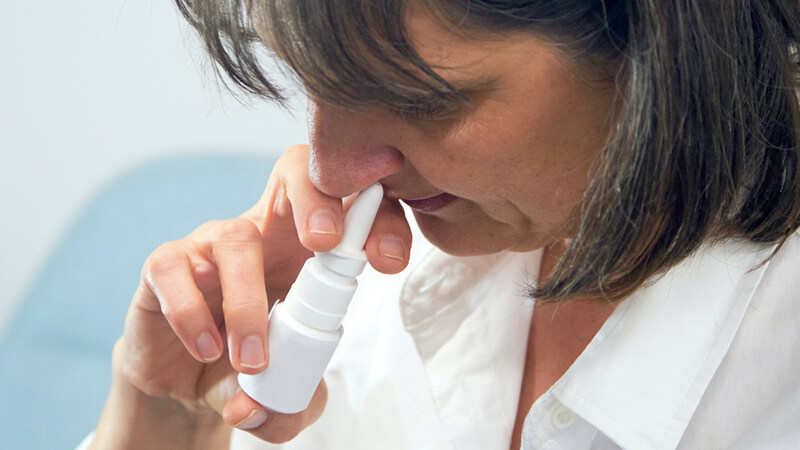Nasal sprays are one of the treatments of choice for allergic rhinitis and chronic rhinosinusitis, yet many people do not know how to use them properly, even if they have been using them for years!
Many people think that their nasal spray does not work for their symptoms, but the problem can be that they aren’t using it correctly. It might be time to ask your doctor what sort of nasal spray you should be using and check whether you have good technique.

The first step in getting a nasal spray is to discuss your symptoms with a doctor, have testing if appropriate, and ideally have someone instruct you on how to use a nasal spray. There are many different brands, doses and nasal spray devices available, which is why it is important to discuss with your doctor or pharmacist which type and dose is right for you.
Intranasal corticosteroid nasal sprays (INCS)
INCS are the first-line treatment for allergic rhinitis. They are designed to make your nose less sensitive. This means that they do not provide immediate relief of symptoms, but rather act as a preventer. It takes about a week of daily use before they start working and they do not work if they are not taken every day. You should start taking them before symptoms start and continue using them even when symptoms are not bad. For those whose allergic rhinitis symptoms occur in spring and summer, they should start taking their ICNS spray just before the start of spring and continue daily until the end of summer. For those who have allergic rhinitis symptoms all year round, they should take their INCS every day of the year.
Combination sprays
There are nasal sprays which combine INCS and antihistamine. These work by making the nose less sensitive (INCS) and at the same time relieving the symptoms (antihistamine).
Saline (salt water) nasal sprays and nasal/sinus rinses
These can also be effective for relieving symptoms. They do not make the nose less sensitive to allergens.
Decongestant sprays
Decongestant sprays unblock and dry the nose. DO NOT use for more than a few days as they can cause long-term problems in the nose.
How to use a nasal spray correctly
Many people think they are doing the right thing but are taking their nasal spray incorrectly. The idea is to spray the surfaces inside your nose with the medication, not sniff the medication into the back of your throat.
The above animation has been shared with permission from the National Allergy Council.
Top tips for INCS
- Talk to your doctor about which nasal spray you should be using
- INCS take at least a week to start working
- Use the INCS every day
- Learn how to use INCS correctly for best results
- You can use a saline nasal spray or rinse before using your INCS, to clean the nose or sinuses and improve how well the INCS works
Remember when using a nasal spray:
- Shake the bottle.
- For first use, or if you haven’t used it for a few weeks, make sure the nasal spray bottle is working properly by spraying the first spray into the air.
- Blow your nose. Use your nasal rinse (if that is part of your treatment) at least 10 minutes before using your nasal spray.
- Tilt your head slightly forward.
- Hold nasal spray in opposite hand to nostril – right hand for left nostril; left hand for right nostril.
- Insert the tip of the nasal spray into your nostril – you do not need to put it up very far.
- Aim the nozzle away from the middle of your nose and direct it backwards into the nasal passage (not upwards towards the tip of your nose, but in line with the roof of your mouth).
- Sniff gently at the same time as spraying.
- Avoid sniffing hard during or after spraying.
- If clear fluid drips out, you need to adjust the angle of the bottle and/or the timing of the gentle sniff.
- Nasal sprays can be an effective way to manage symptoms of allergic rhinitis.
